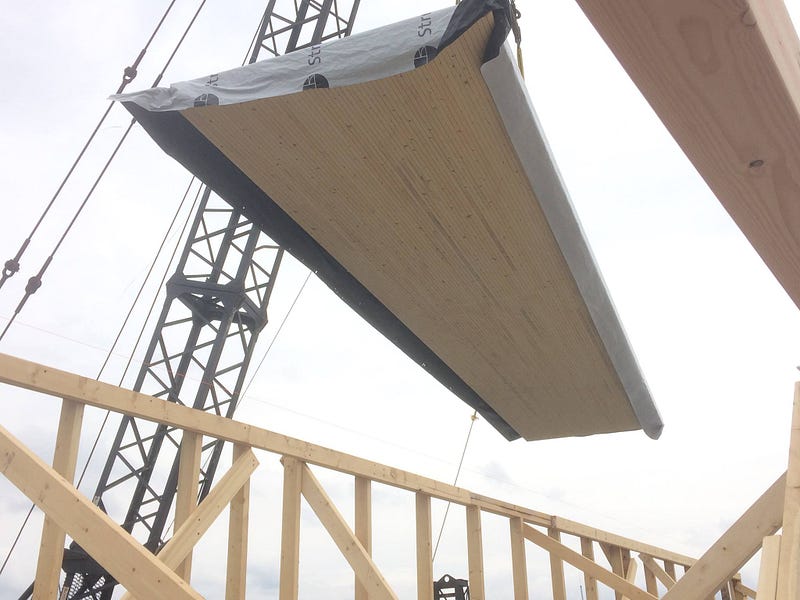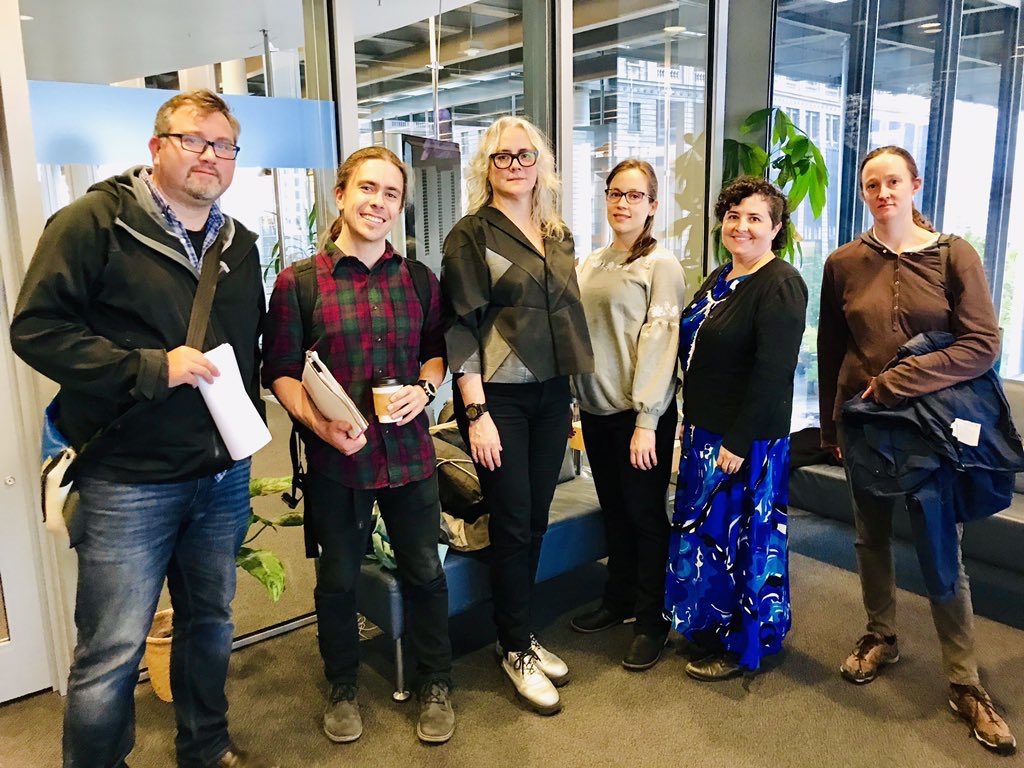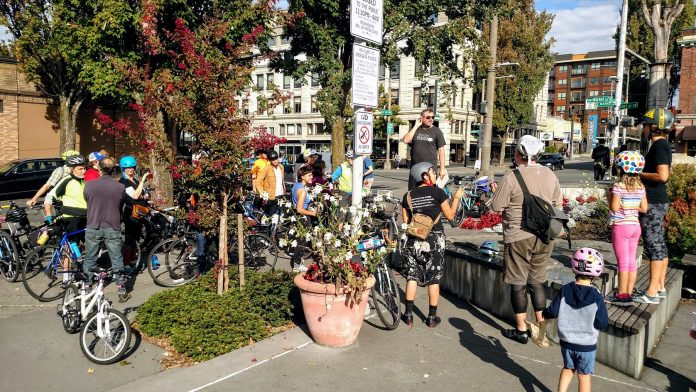Randy Shaw, whose new book ‘Generation Priced Out‘ is getting notable press, claimed that 2018 was: “The year of the YIMBY (Yes in My Backyard). Or if you feel that term is too constraining, 2018 was the year of the grassroots pro-housing activist.” Kriston Capps said pretty much the same thing at CityLab.
Despite getting lapped by Minneapolis, who just weeks ago legalized duplexes, triplexes, and small apartments in the 75% of that city that had been zoned for single-family homes only–Seattle especially has felt like it’s been moving in the right direction, albeit at a glacial pace. This year saw a lot of parallel movement between groups with various agendas, in what could only be described as: promising, hopeful, and powerful.
So here are a few of the highlights from my point of view, and it should be noted this is by no means comprehensive.

Many, many folks came out strongly in support of the city’s affordable housing proposal for surplus land at Fort Lawton and it was a beautiful moment and it felt like a massive turning point. YIMBYs, Democratic Socialists, environmental, transportation, housing activists, and others –all showed up big time. Many even asked the city to go further, and there was even a plug for how the city of Vienna might develop Fort Lawton (as well as Talaris and Roosevelt Reservoir). The project is nearly a decade in the making, held up largely by a handful of homeowners. The latest legal obstacle was shot down. Over 10 years for 230 units of affordable housing, in case you were wondering why we have a housing crisis.
Early in the year, Seattle Councilmember Teresa Mosqueda convened a panel on affordable housing which I got to sit on, and plug some innovative things other jurisdictions are doing. This also set the tone of how Councilmember Mosqueda’s office has worked throughout the year, routinely centering housing policy on those least represented, in a city that has historically catered largely to homeowners. This is important, because Seattle is now a majority renter city, and our land use needs to change to reflect this.
Rachael Ludwick penned a great data-rich piece for The Urbanist on major transit investments happening next to golf courses – some of the most underutilized and wasted urban land in our region, and revealed that we have more acres for golf than zoning levels for dense housing. The transit-adjacent golf course issue is just one of many issues Share The Cities has been instrumental in keeping front and center, and they need volunteers and support ya’ll. Also worth noting Share The Cities’s Laura Loe teamed up with Henry Kramer to pen an awesome piece titled ‘The Case for Ending Apartment Bans’ –relatedly, apartment buildings and affordable housing are banned on 85% of the residentially-zoned land in Seattle.
We saw significant push back against a small but vocal number of homeowners opposed to a small and legal apartment near two major bus lines, and walkable to one of the largest employment centers in the state. The comments delivered to the city for this project also included some of the most heinous statements I’ve ever seen directed at renters –by a local realtor no less.
The Mandatory Housing Affordability rezone public hearings saw many social justice, environmental, housing, and transportation groups turn out in support of more affordable housing. It also allowed for a bit of a dive into to the demographics of urban villages which I covered a bit (urban villages skew younger, more diverse than surrounding single-family neighborhoods, and 25 out of 27 are majority renter–go figure).
In April, the mayor dropped her climate action plan. It was a joke of insufficiency lacking any aspiration or vision. I had some thoughts on why it was awful (it literally proposed nothing to mitigate climate change), and what we should be doing as a city (basically everything we’re not–prioritizing density, affordable housing, biking, transit, car-free pedestrian zones, and livability).
The Seattle Office of Planning and Community Developed dropped the draft environmental impact statement report for backyard cottage liberalization in May, after a single homeowner had successfully appealed the original report (you’d be shocked to hear how common this is). This one was even more thorough than the previous, and highlighted Seattle’s history of downzoning –taking multifamily land and eliminating the possibility of adding more housing. It also showed liberalization would result in more homes and fewer teardowns. Ridiculously, that same homeowner is appealing this legislation yet again, meanwhile we’ve been lapped on this issue as Olympia passed missing middle legislation this year. We’ll get there soon enough.
Seattle’s history of zoning and land use became front and center as we learned that multifamily housing was once legal in every part of the city. The folks at Sightline felt it was important to know, with my piece titled, ‘This is How You Slow-walk into a Housing Crisis.’ That history also made it into many reports published by the city this year, the latest covered by Crosscut.
The city council passed a bombastic parking reform bill that severely reduced parking requirements near transit, increased bike parking regulations, and took a positive step towards addressing climate change and housing costs. Absurdly, this also faced appeal by a handful of homeowners.
There’s also been a ton of pushback against the classist, anti-MHA op-eds in The Seattle Times and elsewher. My op-ed in the Times pointed out that affordable housing is not the enemy.
The city council also passed a bill allowing taller wood buildings –legalizing six (wood frame) over one (concrete) and six-over-two construction, which might make MHA more feasible for certain zoning levels. Five-over-ones, and five-over-twos, were already legal.
The rad folks at Red May let me ramble about Red Vienna and Vienna’s approach to social housing versus Seattle, followed up by a panel discussion with Cary Moon, Charles Mudede, and Philip Wohlstetter.
There was push back against the Mercer Mega Block RFP, which could end up providing zero on-site affordable homes on a massive parcel of land downtown. Cary Moon and I penned this op-ed in Crosscut on abandoning such a detrimental RFP and focusing on using the site to reflect our city’s progressive values. Out of that, a larger alliance of transportation, housing, and environmental groups has been working with the city council to increase transparency and require more aspirational RFPs that reflect our progressive values. We’ll see shortly what the Mayor’s Office was able to negotiate –my guess is it will be nothing as progressive as Oakland’s recent affordable housing win at the Lake Merritt BART station.

The city council passed legislation direction the mayor and Seattle Department of Transportation to complete the basic bike network, and connecting the paltry few protected bike lanes we have downtown.
Many people showed up to demand the Metropolitan King County Council use public funds for affordable housing, instead of subsidizing a billion dollar team (alas, they opted to subsidize a private entity instead).
In October, Senator Guy Palumbo (D-Maltby) announced a new bill for the next legislative session, requiring minimum density zoning near high capacity transit. Hoping for some more solid housing bills coming out of state legislature this next year.
Also in October, 350 Seattle hosted an awesome forum (which I got to participate in), on the intersection of housing and the environment.
After a year of delay by a group largely composed of homeowners from wealthy neighborhoods, the hearing examiner slapped down nearly all of the complaints, allowing MHA to move closer to being passed.
Also on heels of Durkan’s Mercer Mega Block giveaway, the city council passed a disposition policy that would prioritize surplus public lands being utilized for affordable housing. The state had already authorized a similar bill. Huge win.
On the heels of the latest IPCC report on climate change, the incredible Move All Seattle Sustainably (MASS) coalition advocating for improved bike, pedestrian, and transit access was announced and came out with a solid letter for the mayor.
The Seattle Planning Commission dropped a bombastic report (worth the read) on diversifying housing options in Seattle’s single-family zones that take up 85% of the land where housing is legal. On the heels of that, District 4 candidate Shaun Scott dropped an equally bombastic statement on the planning commission’s report. This is one of the many reasons I’m supporting Shaun in his run next year – read his interview with The Urbanist.
Our sole renter on the city council submitted a resolution to use the race and equity toolkit to study Seattle’s urban villages. Less than 2% of Seattle participated in a process that prevents affordable and multifamily housing from being built in most of Seattle. Seattle’s homeowners also killed a 25% affordable housing component of the urban villages, setting up today’s affordable housing crisis.
On the heels of national movement on the issue, the Washington State Building Code Council legalized tall mass timber buildings up to 18 stories tall. We won’t be building the tallest (Vienna’s got a 22-story tower underway, and larger one are planned in northern Europe), but hopefully this kickstarts some tall, mass timber affordable housing.
And finally, Seattle Representative Nicole Macri (D-Capitol Hill) announced legislation at the state level for tenant protections. We will need a lot more action for renters at the state level in coming years – especially as affordable housing continues to become more and more scarce.
A lot of things to be happy about coming out of 2018, but things have been slowed and delayed by those defending the status quo. Our mayor isn’t going to step up amidst growing housing and climate crises, so more will need to be done. Seattle should be doing a lot more, and a lot better, on this front. 2019 is shaping up to be a pivotal year in the city’s history. Will the inequitable status quo finally be righted? Will Seattle become a city for all, and not the well off? Will we finally hit the correct percentage of single-family zoning (hint: it’s zero). We shall see…
This is a cross-post from Mike Eliason’s blog on Medium.
Mike is the founder of Larch Lab, an architecture and urbanism think and do tank focusing on prefabricated, decarbonized, climate-adaptive, low-energy urban buildings; sustainable mobility; livable ecodistricts. He is also a dad, writer, and researcher with a passion for passivhaus buildings, baugruppen, social housing, livable cities, and car-free streets. After living in Freiburg, Mike spent 15 years raising his family - nearly car-free, in Fremont. After a brief sojourn to study mass timber buildings in Bayern, he has returned to jumpstart a baugruppe movement and help build a more sustainable, equitable, and livable Seattle. Ohne autos.


